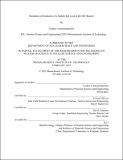Simulation of Irradiation of a Molten Salt Loop at the MIT Reactor
Author(s)
Carayannopoulos, Loukas
DownloadThesis PDF (16.97Mb)
Advisor
Shirvan, Koroush
Terms of use
Metadata
Show full item recordAbstract
Over the past decade or so, molten salt reactors (MSR) have gained a lot of interest within the nuclear energy community, with two of the ten reactor designs supported by the Department of Energy’s (DOE) Advanced Reactor Development Program being MSRs. Commercializing MSR technology requires new experimental facilities to improve understanding of molten salt behavior in reactor-like environments. The Nuclear Energy University Program approved a project to design and build a molten salt test bed that will be irradiated by the MIT Reactor (MITR), which will provide testing capabilities that have not existed since the shutdown of the Molten Salt Reactor Experiment (MSRE) in 1969. The main experimental goals of the project are (1) to build a molten salt loop that operates between 550°C and 700°C and is irradiated by neutrons from the MITR to duplicate conditions in a molten salt reactor, (2) to produce data regarding the transport, diffusion, and dissolution of tritium and radionuclides in molten salts, and (3) to provide a facility for testing chemistry control, salt cleanup, tritium control, and instrumentation.
To safely design this facility, an understanding of the radioactivity generated in the loop is needed. The purpose of this work is to model the irradiation of the salt loop, using MCNP and Serpent, to determine the necessary amount of radiation shielding and the activation of different salts proposed for use in MSRs. The salts considered are FLiBe, LiF-BeF₂-ZrF₄-UF₄ used in the MSRE, LiF-BeF₂-UF₄ suggested as a fuel salt by Terrestrial Energy and Flibe Energy, LiF-BeF₂-ThF₄ suggested as a blanket salt by Flibe Energy, and NaCl-UCl₃ suggested as a fuel salt by TerraPower. FLiBe will generate 1.413 ± 0.024 mCi/hr of tritium, with all other fluoride salts generating similar quantities, and a total of 1413 ± 24 Ci over a 1000-hour period – the maximum continuous operation time proposed for the facility. The maximum radioactivity produced in 1000 hours of operation is 546.9 Ci in the chloride salt. The quantities of tritium and other radioactive products formed in each of the salts make this facility an important tool for the development of MSR technology.
Date issued
2023-02Department
Massachusetts Institute of Technology. Department of Nuclear Science and EngineeringPublisher
Massachusetts Institute of Technology